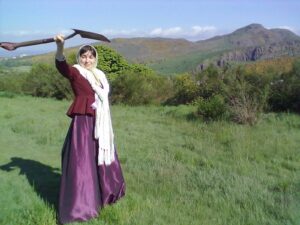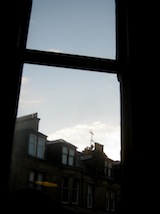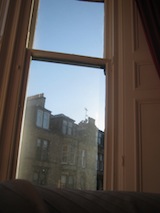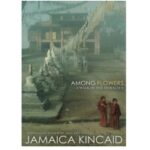
One of the more colourful stories to emerge from Frederick Douglass’s time in Edinburgh in 1846 is the one about him carving a provocative slogan on the hillside above the city with two women abolitionists. The full details of the episode are probably lost to history and may require imaginative reconstruction. What do the archives tell us?
At City Hall in Glasgow on Tuesday 21 April, the English abolitionist George Thompson whipped up the audience with the slogan that had come to dominate the campaign to persuade the Free Church of Scotland to break its ties with pro-slavery Presbyterians in the United States, ties symbolised by the donations it had accepted after a fund-raising mission had visited there two years before.
Yes, send back the money! Let that be the cry – and teach it to your children, and that when they see one of Scotland’s ministers in the street, they may in infantile accents cry – ‘Send back the money! Women of Scotland! let the words become so familiar to you, that you shall in mistake say to those who sit at your table – ‘Will you please to send back the money?’. (Laughter and loud cheers.) Let every corner cover its walls with capitals, a foot square in size, ‘Send back the money.’ (Cheers.) Inscribe upon the pedestal of John Knox’s statue – ‘Send back the money.’ (Cheers.) Write upon the tombs of those who died (Cheers.) From the summit of Arthur’s Seat, let a banner perpetually float, with the watchword, – ‘Send back the money.’ (Cheers.) Carve deep into the Salisbury Crags the words ‘ Send back the money.’ Inscribe on the Calton Hill, in characters that may be seen from St. George’s Hall, ‘Send back the money.’ (Immense cheering.).1
The slogan had already made its appearance in towns where Douglass had addressed meetings. ‘We understand that, in Glasgow and Paisley, the old plan of advertising blacking had been resorted to, and on every wall and public place is chalked up the significant phrase, “Send back the money”,’ noted the Aberdeen Herald.2 Douglass himself enjoyed telling audiences of the consternation such graffiti had provoked in Arbroath where
there was painted in blood red capitals, SEND BACK THE MONEY. A woman was sent to wash it, but the letters still remained visible, SEND BACK THE MONEY. (Great applause.) A mason was afterwards got to chisel it out, but there still was left in indelible characters, SEND BACK THE MONEY. (Cheers.)3
The John Knox statue that George Thompson mentions was undoubtedly the one towering over Glasgow Necropolis (hence the reference to the tombs). But the other sites Thompson recommends to the would-be graffiti artist – Arthur’s Seat, Salisbury Crags, Calton Hill – are all in Edinburgh. Why? Because he and his fellow activists, including Douglass, were about to move to the capital the following week, and hold a series of public meetings through May in advance of the General Assembly of the Free Church which would open at the end of the month. As he expected, his speech was reported in both the Edinburgh Evening Post (on 2 May) and the Caledonian Mercury (on 5 May).
The idea may have tickled Douglass, who shared the platform with Thompson in Glasgow. Perhaps they joked about the possibility as they warmed themselves by the fire at the York Temperance Hotel on Nicolson Street once they arrived in Edinburgh. Surely there would be no shortage of willing co-conspirators, inspired after coming across Thompson’s suggestion in the Edinburgh papers. At any rate, a Rev Dr Campbell told a meeting in London later that month:
In one of the Scotch papers this man (Douglass), this mighty man, is represented as going to the foot of Arthur’s Seat, with a spade, and two fair Quakeresses as his companions, where he began to carve out with the spade, on the green grass, very beautifully ‘Send back the money.’ (Laughter, and loud cheers.) The paper goes on to say, that he was apprised in the midst of the philanthropic work that it was a felony, and that he would be at the tender mercies of a Mr. Baillie Gray. I do not think that a man who has braved the fury of the slave-holder, would be likely to tremble at the name of Bailie Gray. (Cheers).4
Historians have usually identified the ‘two fair Quakeresses’ as Jane Smeal and her step-daughter Eliza Wigham, two women who feature in Women on the Platform (pdf), showcasing research by the DRB Scottish Women’s History Group. Office holders in the Edinburgh Ladies Emancipation Society, they lived at 5 South Gray Street, ten minutes’ walk from the Crags, and, in those days, in sight of them. As active abolitionists they were already known to Douglass, who probably visited their home. After all, in Glasgow he had enjoyed the hospitality of Jane’s brother William, of the Glasgow Emancipation Society.
But to my knowledge, no one so far has discovered which of the ‘Scotch papers’ Campbell relied on for his story. In fact it appears to have been the Witness, the twice-weekly newspaper sympathetic to the Free Church, edited in Edinburgh by Hugh Miller.
SEND BACK THE MONEY. – It was magniloquently urged by Mr Geoge Thompson upon his admiring auditors a few weeks ago, that they ought to carve upon the front of Salisbury Crags, in conspicuous characters, ‘Send back the money,’ and we have no doubt there were amongst his audience individuals foolish enough to attempt the arduous task, but as little can we doubt that the callous and obdurate rock would mock their impotency. Mr Frederick Douglas, however, forgetting that the hills and dales of Scotland are not quite such commons as the praries of his own native wilds, hit last week upon a simpler expedient for engraving upon the face of our picturesque scenery these notable words, and immediately hied, spade in hand, accompanied by two ladies belonging to the Society of Friends, to a spot in the vicinity of the Queen’s Drive, which is at present being laid out around the base of Arthur Seat, and began to carve this vulgar cry in graceful characters upon the green sward. Information having reached the persons entrusted with the charge of the grounds, we understand that Mr Douglas was immediately taken to task, and given to understand that he was liable to be made answerable for the offence to Bailie Gray, ‘one of the Magistrates of Edinburgh,’ upon which the philanthropic man of colour expressed deep contrition for the crime, and here the matter at present rests.5
The Witness regularly attacked Douglass and his associates, and Miller no doubt seized on this event as an unmissable opportunity to poke fun yet again. Miller is best known today for his contributions to the science of geology, suggesting that he particularly enjoyed portraying the trio as stupid enough to want to etch the ‘vulgar cry’ in the ‘obdurate rock’ itself before realising that turf might prove more malleable.
That their efforts were apparently halted by the authorities gives him the excuse to end his report with the ‘philanthropic man of colour’ humiliated and having to apologise for his ‘crime’. That Douglass was assisted by ‘two ladies belonging to the Society of Friends’ would have further diminished him in Miller’s estimation given the editor’s previous mockery of the radical abolitionists for their support for women’s rights, confident his readers would have been amused when he invited them to imagine
armed regiments of equalized women charging in petticoat breeches some male anti-equal-right enemy, who had come to invade their country from without; and squadrons of female dragoons emancipated from matrimonial thrall and the side-saddle, trampling all horrid into dust, broken cohorts of imperative husbands and despotic lovers, who had assailed them in unnatural rebellion from within.6
But while we should be cautious of the way Miller shaped his account to suit his agenda, did he made it up? The detail of the location (‘in the vicinity of the Queen’s Drive’) and the naming of ‘Bailie Gray’ (who was certainly on the City Council at this time) lends an air of verisimilitude, even if the incident was open to an interpretation more favourable to Douglass, such as the heroic (though still masculinist) narrative offered by Campbell in London.
Following his third visit to Europe in his late sixties, Douglass recalled his role in the ‘Send Back the Money’ campaign forty years earlier. According to a report of a speech published in October 1887 he said:
The debate was sharp and long – the excitement was great. Nearly everybody in Scotland outside the Free Church, were on the side of freedom, and were for sending back the money. This sentiment was written on the pavements and walls and sung in the streets by minstrels. The very air was full of send back the money. Forgetting that I was in a monarchy and not in this republic I got my self into trouble by cutting, send back the money in the back of a seat. I was soon thereafter arrested for trespassing on the Queen’s forests, and only got off by a written apology.7
This appears to be the only occasion Douglass publicly referred to the incident, though it is still possible that, with the passage of years, he may have been reciting an abolitionist legend rather than remembering an actual event.
The reference to the encounter with the grounds-keepers is curious, however. It echoes another confrontation recounted a few months before by James Buffum, the Massachusetts abolitionist who had accompanied Douglass across the Atlantic the previous year. Buffum, speaking in Dundee, told his audience:
He had sailed down the Clyde. On landing, a beautiful hill was before him; he wished to climb this hill to obtain a prospect around him, but was stopped in his attempt by Lord Blantyre’s gamekeeper. If the Black population in America were not free, the hills of america were so.8
Douglass more than once expressed the pleasure he took in dwelling amid ‘the free hills of old Scotland’, partly to accentuate the prejudice and intimidation he had endured in the United States – and would again when he returned. But sometimes those hills proved to be less free than the rhetoric demanded.
Last updated 10 June 2020
Notes
- Free Church Alliance with Manstealers (Glasgow: George Gallie, 1846), 34-5.
- Aberdeen Herald, 16 May 1846.
- Frederick Douglass, Paisley, 25 April 1846 as reported in the Renfrewshire Advertiser, 2 May 1846, reprinted in The Frederick Douglass Papers. Series One: Speeches, Debates, and Interviews, Volume 1: 1841–46, edited by John W. Blassingame (New Haven: Yale University Press, 1979), pp. 242-3.
- American Slavery: Report of a Public Meeting Held at Finsbury Chapel, Moorfields, to Receive Frederick Douglass, the American Slave, on Friday May 22, 1846, with a Full Report of His Speech (London: C. B. Christian, 1846), 27.
- Witness, 20 May 1846. The report was reprinted elsewhere, including the Fife Herald (21 May 1846), which corrected the spelling of Douglass’s name.
- Witness, 25 December 1844.
- Christian Recorder, 13 October 1887. The reporter, presumably unaware of Edinburgh’s topography, rendered Douglass’ ‘Arthur’s Seat’ as ‘a seat’, as the closest approximation that made sense.
- Dundee, Perth and Cupar Advertiser, 30 January 1846.








